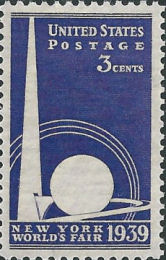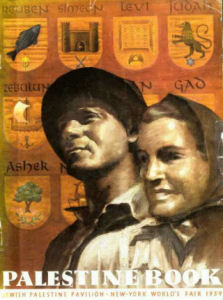|
|
|
|
| A 1939 reminder to remember is embedded in the auditorium wall. | ||
|
|
|
|
| A 1939 reminder to remember is embedded in the auditorium wall. | ||
|
Did you know there was a Zionist Pavilion in the 1939 Worlds Fair? The New York World's Fair, which opened in 1939 and closed in October 1940, had a Jewish Palestine Pavilion. The exhibit, whose presence had been opposed by many, told the Zionist story to four million visitors. It was nearly a decade before the State of Israel was recognized by the world. In 1941 a precious
remnant of that exhibit was installed in the Silver Sanctuary of The
Temple - Tifereth Israel in University Circle. It remains there
today, now part of the auditorium of the Milton and Tamar Maltz
Performing Arts Center of Case Western Reserve University. |
 |
|
|
|
|
|
Photo from
Wikipedia entry on New York 1939 - 1940 World's Fair |
|
Walk through the lobby of the Milton and Tamar Maltz Performing Arts Center of Case Western Reserve University and enter the auditorium. Then look to your right. On the wall in the back (southeast) corner of the room you will see a basalt plaque with the Hebrew word "Yizkor" (Remember) above the words IN MEMORIAM. Below this plaque was once the memorial book in
which Temple members would have inscribed the names of deceased
family members. The book, enclosed in a glass case for protection, would be open to the page for the current
day. At services each
week the names of those who had died the
current week and those who had died that week in past years - "yahrzeits"
- would be read.
Mourners and the congregation would stand and recite the "kaddish"
(memorial prayer). The Memorial Book is now at The Temple - Tifereth Israel in Beachwood, but the plaque remains. It is embedded in the wall of the sanctuary and could not be moved safely. The
plaque with its Eternal Light had been crafted in Israel and had been on display in the Jewish
Palestine Pavilion in the 1939 - 1940 World's Fair in New York. |
|
|
|
The dedication under the Yizkor plaque reads as follows: IN REVEREND AND LOVING
MEMORY OF |
|
How Rabbi Silver knew the Yizkor plaque was available The missing part of this story was how Rabbi Abba Hillel Silver learned about the availability of the Yizkor plaque from the Jewish Palestine Pavilion at the Worlds Fair. Thanks to David Matlow, attorney, a leader of the Jewish community in Toronto and student of Zionist history, we now know. On May 21, 2018 he sent an explanatory email and attached images of several pages of the catalog that offered for sale the art and sculpture from the Pavilion.
War between Italy and Great Britain on June 11, 1944
closed the Mediterranean. The undated catalog was probably printed
in July 1940. We show below its first paragraphs, which explain the
reason for the sale, and the first listing, which was for the Yizkor
plaque. Rabbi Silver may have seen copies of the catalog as the
president of the United Palestine Appeal and at The Temple, one
of the nation's largest synagogues. |
|
|
|
|
|
Looking for more on the plaque at the Worlds Fair |
|
|
Fortunately the 144 page souvenir book has been preserved online. We show at the right the cover of the souvenir book. Two parts of the
souvenir book are shown below. First is the
artist's rendition of the entrance where, also at the right
of the entrance, the Yizkor plaque would have hung. Second
is the book's text
which tells of a Hebrew inscription (Yizkor) and an Eternal Light,
but there is no picture of the Yizkor plaque. The last image
is a photo taken at the opening of the Jewish Palestine
Pavilion. We see the Hechalutz Zionist youth dance
troupe and behind them the first visitors to the Pavilion. Unfortunately the
photo does not show the wall with our Yizkor plaque. Arnold Berger, editor |
 |
|
|
|
|
|
|
|
. |
|
Below: the Memorial Plaque as visitors saw it In May 2001 Professor Barbara Kirshenblatt-Gimblett, a scholar of Yiddish and Jewish studies, posted a page about the Jewish Palestine Pavilion on the New York University website. Somehow the page survived and at last we can show an image of the Yizkor Memorial Plaque as visitors would have seen it in 1939 and 1940. |
|
|
|
When was the plaque installed? |
|
|
The October 19, 1941 issue of The TEMPLE BULLETIN in its GIFTS and BEQUESTS column mentioned the gift of the Memorial Plaque in what it called "the Memory Corner". As the Bulletin did not publish in the summer months, we assume that the plaque was installed some time during the summer of 1941. |
|
|
Beatrice Klausner Gray talks about her father Nathan Klausner and the Yizkor plaque |
|
|
|
October 2017 Bea Gray is seated third from the right. |
|
Bea Gray remembers that her father Nathan Klausner so admired Rabbi Abba Hillel Silver that the family joined The Temple in 1929. For Nathan that was a leap from the Orthodox Linn Drive Synagogue (the Tetiever shul) to the Classic Reform Temple, though he remained a member of the Linn Drive "shul" until his death. He and his wife Mary had seats on the main floor of the sanctuary and often attended services. Bea remembers starting Sunday school there at age 8 and being confirmed at The Temple. How did her father knew the plaque was available? He didn't. Rabbi Silver told him it was and that The Temple would make all the arrangements. So Nathan wrote a check - presumably a large one - to The Temple. How did Rabbi
Silver know Nathan Klausner could readily make such a
gift? Soon after
joining The Temple Nathan purchased two seats in the center
of the main floor of the sanctuary for $1,000. That was
twenty times a year's dues and an act that would mark him as
a man of means. Further, Cleveland's weekly English language
Jewish papers of the period (Jewish Review &
Observer and Jewish Independent) mention Nathan
in several fund raising campaigns for relief of
Jewish refugees from Germany and other good causes. He had
also been a trustee of the Cleveland Zionist Society whose
president was Rabbi Abba Hillel Silver. |
|
|
On other websites: |
|
|
Thanks for their help creating this page
● Jordan Davis (Maltz Performing Arts Center) |
| 10/20/17 updated 5/22/18 |
| Top of Page Synagogues CJH Home |